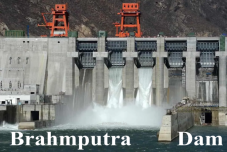Brahmaputra Dam
Recently, China approved the Brahmaputra dam’s construction, close to the Indian border and defended its plan to build the Brahmaputra Dam on the Brahmaputra river in Tibet, saying the project would not “negatively affect” the lower riparian states of India and Bangladesh and that safety issues had been addressed through decades of studies.
About Brahmaputra Dam
China has approved the construction of the world’s largest dam, stated to be the planet’s biggest infra project costing USD 137 billion, on the Brahmaputra River in Tibet close to the Indian border. This project is located in the ecologically fragile Himalayan region, along a tectonic plate boundary where earthquakes occur frequently.
China has proposed building a hydroelectric dam on the Yarlung Tsangpo River in the Tibet Autonomous Region, which lies close to the Indian border in Arunachal Pradesh. The dam is expected to be one of the world’s largest, with a planned capacity far exceeding most existing hydropower projects.
The Brahmaputra dam project was incorporated into China’s 14th Five-Year Plan (2021-2025) and National Economic and Social Development, along with Long-Range Objectives Through the Year 2035, adopted by the CPC Plenum in 2020.
India which is currently constructing its own dam in the same river in Arunachal Pradesh. Both India and China in 2006 established the Expert Level Mechanism (ELM) mainly to discuss the various issues related to trans-border rivers under which China provides India with hydrological information on the Brahmaputra and Sutlej river during the flood seasons.
Aim of Brahmaputra Dam
- This hydropower project according to China, aimed to speed up the development of clean energy and respond to climate change and hydrological disasters.
- Another aim claimed by China is to use the dam for flood control, irrigation, and water storage, ensuring a more reliable water supply in the region, especially during dry periods.
- This project is also seen as part of China’s broader strategy to exert greater control over its river systems, particularly those that flow into neighboring countries.
Challenges/Main Impact on India due to Brahmaputra Dam
- Water Security Concerns
- Brahmaputra is a major river for northeastern India and building of Brahmaputra Dam on the Yarlung Tsangpo or Brahmaputra river could reduce the flow of water downstream into India which would affect India’s agriculture, drinking, irrigation and other water needs in particularly for states like Arunachal Pradesh, Assam, and parts of West Bengal.
- Building the Brahmaputra Dam may lead to the altering of natural river flow cycles and any change in the seasonal flow cycles may lead to flooding, droughts, or water scarcity during dry periods and also create challenges for local inhabitants.
- Building the Brahmaputra Dam on Brahmaputra river could trap sediments that are essential for maintaining the fertility of the river’s floodplains, particularly in Assam and nearby regions which may lead to declining of agricultural productivity in those areas that are important for rice cultivation.
- Geopolitical Tensions
- India since many years has concerned about China’s unilateral control over the transboundary rivers, mainly those that flow into the India and due to the absence of a formal water-sharing agreement between India and China over the Brahmaputra river makes India vulnerable to China’s unilateral actions.
- Brahmaputra Dam is being built near the India-Tibet border in Arunachal Pradesh where there is already ongoing dispute between the two. And the China’s activities in this region including this dam construction could further gives rise to the border tensions and complicate existing diplomatic relations.
- India might seek to gain international support on the issue, particularly from countries like Bangladesh, which is also affected by the Brahmaputra. There could be efforts to build multilateral pressure on China to ensure that downstream countries’ interests are considered, particularly if the dam leads to a significant reduction in the river’s flow.
- China’s step to control the upper reaches of the Brahmaputra river could be seen as a potential military and geopolitical advantage. This is especially concerning given that both countries have unresolved territorial disputes along their shared border.
- Environmental and Ecological Impact
- Brahmaputra river supports a rich and diverse ecosystem with several endangered species such as the Brahmaputra dolphin and the one-horned rhinoceros etc. and building this large dam on this river may affect the river’s natural flow and the aquatic life and may reduce the biodiversity.
- Brahmaputra river is prone to flooding and building this large dam could exacerbate flood risks downstream in India, especially in Assam and nearby regions and mainly the local inhabitants, where the river frequently overflows during the monsoon season. And thus, altering the natural course and floodplain dynamics of this river by building the dam may lead to increased erosion, damaging the infrastructure and agricultural land and also increasing the vulnerability of people living along the river.
- Brahmaputra’s fertile floodplains, particularly in Assam, are crucial for rice cultivation and other agricultural activities. Any alteration in the river’s flow could impact the silt deposition necessary for maintaining soil fertility and directly affecting agriculture and farming of those nearby areas.
- Impact on Local Inhabitants
- While the dam is being built in Tibet close to the Indian border, there are several concerns that changes in the river’s flow could have downstream impacts on Indian communities living in the Brahmaputra basin. In the long term, communities along the river may experience changes in their access to water, fisheries, and agriculture.
- This large dam on this river may cause flooding in low-lying areas along the Brahmaputra, displacing people and creating socio-economic disruptions in the region, especially in Assam and nearby regions.
About the Brahmaputra River
Brahmaputra is one of Asia’s major rivers, flowing through China (where it is known as the Yarlung Tsangpo), India, and Bangladesh. It originates in Tibet and flows through the Indian states of Arunachal Pradesh and Assam before entering Bangladesh, where it merges with the Ganges and eventually flows into the Bay of Bengal.

